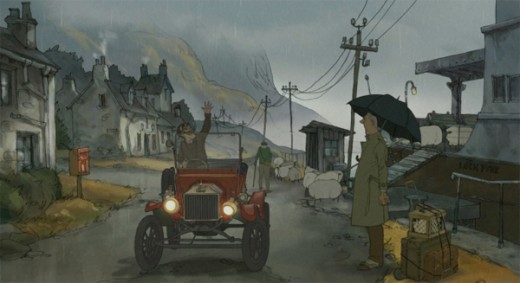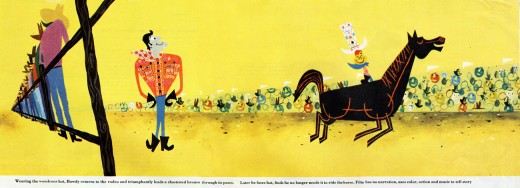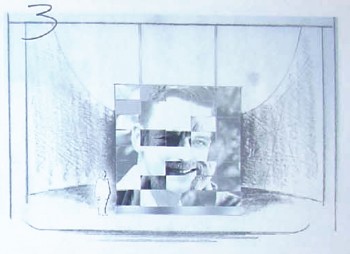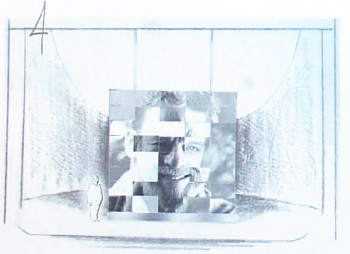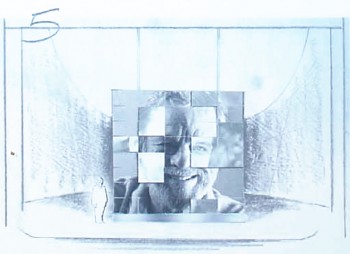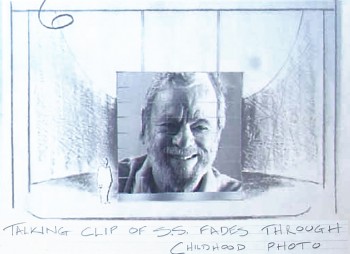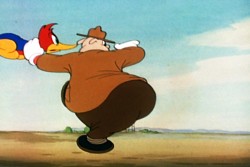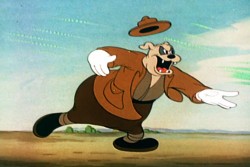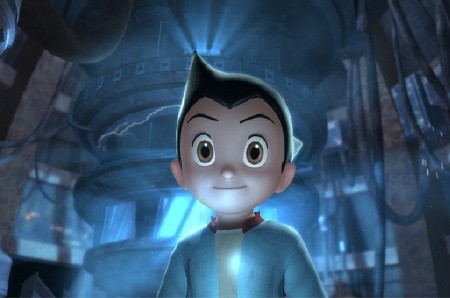Category ArchiveCommentary
Animation &Articles on Animation &Commentary 06 May 2010 07:21 am
Dragons & Fanny
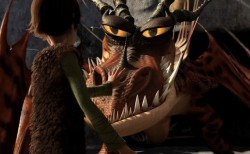 - For the past few weeks, Michael Barrier’s review of How to Train Your Dragon has been on my mind. Actually, not most of the review, just the last two paragraphs. Most of the review talks about the Dreamworks film, and, I must say, it doesn’t encourage me to see it (which I eventually will most certainly do – once they screen it in 2D in New York).
- For the past few weeks, Michael Barrier’s review of How to Train Your Dragon has been on my mind. Actually, not most of the review, just the last two paragraphs. Most of the review talks about the Dreamworks film, and, I must say, it doesn’t encourage me to see it (which I eventually will most certainly do – once they screen it in 2D in New York).
I haven’t yet seen it , but the film, from the ads I’ve seen, looks like the generic Dreamworks product. All of the characters are supposed to be Vikings living in the First Century, but they act and sound like generic animated characters in the 21st Century. It’s just about a given for such current product. The stock facial expressions, the overarching eyebrows, the attitude. In all of the ads and clips I’ve seen, America Ferrara screams every one of her lines. That’s what poses for acting today in most animated films – a direct influence of TV.
Perhaps I’m wrong, but I somehow doubt it. I’ll find out for myself when I do see it. (After all I put down Kung Fu Panda, and I now think pretty highly of that film.) Regardless, this isn’t the part of the commentary that Mike’s written that has my thoughts rambling about.
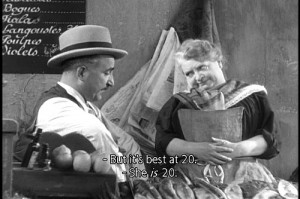 He jumps in his review to Marcel Pagnol’s Fanny Trilogy. Seeing these three films is perhaps one of my all time favorite movie experiences. They played in NY in the 70’s on three consecutive Mondays. I got so hooked into it, I looked forward enormously to those Monday showings. Mike describes them beautifully. All character development and a simple straightforward story that just about breaks your heart. It’s a wonderful film experience despite the fact that it’s a crusty old 1930’s film with lots of soft grays and soft focus. They’re obviously sets built around the Marseilles they’re pretending to create, but you buy it all. At least I did; it’s so wonderfully Romantic.
He jumps in his review to Marcel Pagnol’s Fanny Trilogy. Seeing these three films is perhaps one of my all time favorite movie experiences. They played in NY in the 70’s on three consecutive Mondays. I got so hooked into it, I looked forward enormously to those Monday showings. Mike describes them beautifully. All character development and a simple straightforward story that just about breaks your heart. It’s a wonderful film experience despite the fact that it’s a crusty old 1930’s film with lots of soft grays and soft focus. They’re obviously sets built around the Marseilles they’re pretending to create, but you buy it all. At least I did; it’s so wonderfully Romantic.
(Perhaps, that’s a generational thing. I talked an intern in my studio into watching Citizen Kane, and she couldn’t get through it. The B&W was too distracting for her, and she found the film boring. What can you say?)
Mike Barrier rightfully makes the leap to Snow White and the Seven Dwarfs, a natural link – animation wise – to Pagnol’s trilogy. The approach is very similar. Somehow I’d never have seen the link to these films, but it works. Despite the enormous difference in story, the dependence on character development and motivation are alike. A sweet, simple, direct story with very strong character personality holds you tightly throughout.
A lot of this approach stayed with the Disney features right through Sleeping Beauty. I love the first 10 or 15 minutes of all those films; nothing but character setup, and they’re all wonderful. Things started to change with 101 Dalmatians and had been just about abandoned by the time they got to The Aristocats. Character suddenly became reliant on celebrity voices. Thanks to the star turns such as Phil Harris’ Baloo the Bear in Jungle Book, it became easier for animators to pull their characters together. Let the voices do the heavywork, and in The Aristocrats, they ran with it to the film’s detriment.
Now we get unidentifiable celebrities, like America Ferrara, shouting their lines but adding nothing to the character’s personality. I’m not even sure if her name will help sell a DVD. Given these flat voices, the animators turn to their stock poses and facial expressions, and the end result is a sad lot.
I’d like to think that Chris Sanders and Dean DeBlois have surpassed the Dreamworks formula and taken their film to another level. I have been a big fan of Lilo and Stitch, although I think much of the story is hackneyed nonsense. (Whenever we have to see aliens fighting from their spaceship, it’s hard to reconcile that with the wonderful character traits between Lilo and Stitch, themselves.) The beautiful artwork choices help carry you through that film. Mike suggests that the end of Dragon may have as big a problem, and he offers to blame that on the executives above Sanders and DeBlois. Perhaps, but Lilo and Stitch had similar problems.
Mike Barrier suggests that that isn’t the entire case with How to Train Your Dragon, and I do hope he’s right. But nothing I’ve seen to date lets me expect it. I do want to be pleasantly surprised, and I’ll let you know if I am.
The film I’m really waiting to see is Sylvan Chomet’s The Illusionist. The story in Triplettes of Belleville fell apart, but the execution and development of the principal personalities was so fine, that the film offered me plenty – and plenty of hope. I do hope and almost expect to see that he has taken this approach to another level. What little I’ve seen leads me to believe I may not be disappointed.
Animation &Commentary &Independent Animation 22 Apr 2010 07:30 am
Toe Tactic & Howdy Doody
- I’m a bit late in reporting this, but I just found Emily Hubley‘s excellent feature, The Toe Tactic, on the Sundance Channel. I’ve reviewed the film in that past and have shared some of my thoughts. Here’s my review of the DVD.
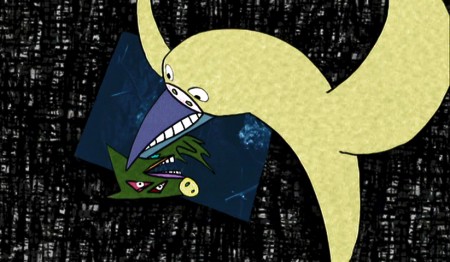
Written and directed by Emily Hubley.
Voices of: David Cross, Andrea Martin,
Eli Wallach, Marian Seldes, Don Byron
Animation by Jeremiah Dickey and Emily Hubley.
The show can be seen on these dates and times in April. Record it if you can’t watch it live.
April 21 4:10am
April 25 10:00pm
April 26 3:55am
April 26 11:45am
- One of the more amazing posts I’ve seen on line in recent weeks (maybe I should say months) is Cartoon Brew TV’s >Howdy Doody and His Magic Hat. This UPA film by Gene Deitch seemed to be lost until Jerry Beck and Amid Amidi were able to discover a good quality print that they’ve put on line.
The piece has to be seen as an edxcellent bit of historical discovery. Deitch’s direction is first rate given the obviously meagre budget. Cliff Roberts’ color design is first rate (given the slight color deterioration of the print) and offers a rich original bit of life. Duane Crowther‘s animation is limited to the point where it might be called more of an animatic than an animation, but even that is done in a spirited sense of fun.
The real find for me was the brilliant score by Serge Hovey. I don’t know his work, but I’m certainly going to be searching to find out more about this composer. The score threads it all together and the playful way that Crowther animated off the score indicates that it was probably prerecorded.
I’m pleased to see this film has been found (thanks, apparently to the work of Dave Gibson for finding the film at the Library of Congress, and to OndÅ™ej MuÅ¡ka for the restoration work on the print.) This is not the greatest film ever made, nor even one of the best UPA shorts. However, it was a missing artifact in the career of a key director in animation’s history. It’s also an absolutely original looking piece that stands above many of the average films of today.
This film is just the tip of the iceburg from the guys at Cartoon Brew. When they’re on it, they’re on it. They share information before anyone else gets the news; they share historical films (such as Howdy Doody and another post of Flebus from Ernie Pintoff while at Terrytoons – posted to memorialize the passing of Allan Swift, the NY mega voice artist), and they present new works we might otherwise miss.
But at this point, everyone in animation knows that this is the first site to visit when sparking up the computer.
Commentary &Layout & Design &Theater 13 Apr 2010 05:47 am
Sondheim on Sondheim
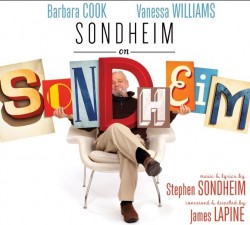 - This past weekend I saw a new Broadway show produced by The Roundabout Theater Company, playing at Studio 54. Sondheim on Sondheim is a show which revisits all of Stephen Sondheim’s lengthy and brilliant career in the theater.
- This past weekend I saw a new Broadway show produced by The Roundabout Theater Company, playing at Studio 54. Sondheim on Sondheim is a show which revisits all of Stephen Sondheim’s lengthy and brilliant career in the theater.
Barbara Cook, Vanessa Williams and Tom Wopat lead a cast of eight who perform work from the Sondheim catalogue of songs, while cascading through the history of the man and, as a result, the history of modern theater – post Rodgers and Hammerstein.
The set for this is a modernist construction by designer Beowulf Borritt. If you ask me, this extraordinary design is a brilliant turn for theater. There’s a construction of 35 multiple screens that tie together or in parts projecting film, video, slides. Stephen Sondheim is a participant in the show in that he’s always there in some projection talking about the shows, his career, his cocreators and producers. The highlight of the show, for me, was the end where Sondheim plays “Anyone Can Whistle” on the piano, and the cast sings to this. Simple and very emotional.
Through a lot of searching I was able to locate some of his original watercolors on line and thought I’d show some of these. A couple came from a slide program on the NYTimes which spoke about the use of projections in theater designs. This has fascinated me since my work on Woman of the Year, projecting an animated character behind the actor onto a 43 foot screen. (The animation work on Sunday in the Park with George – also a Roundabout Production at Studio 54 – was a projection miracle, though the rest of that recent production left me a bit cold.)
Let’s start with a short storyboard sequence which shows Sondheim aging.
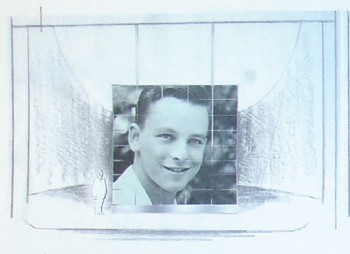 1
1The sequence begins with a young Stephen Sondheim.
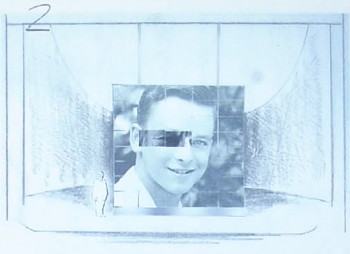 2
2
Slowly, and musically the image transforms . . .
The set . . .
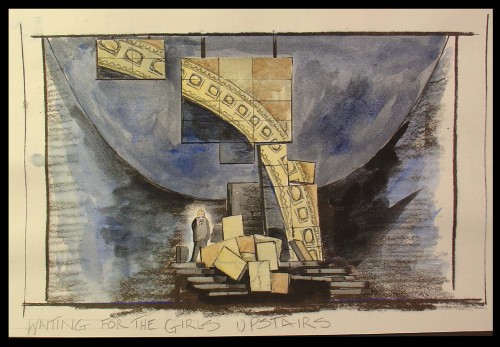
The set is a somewhat abstract construction that utilizes many
screens of digital projections both video and slide.
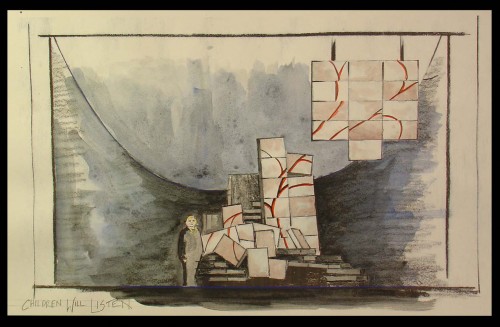
You can see how the parts shape shift even though
the projections continue on the parts.

Lighting by designer Ken Billington is also brilliantly part of this set.
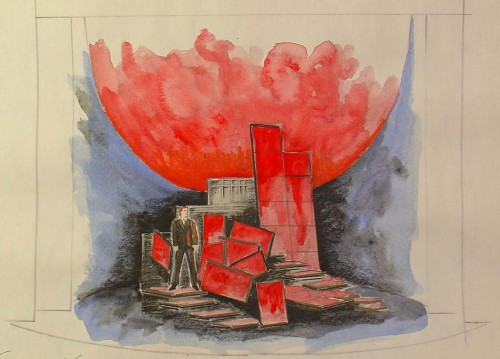
All of the parts – lighting, set, projections – all act as one.
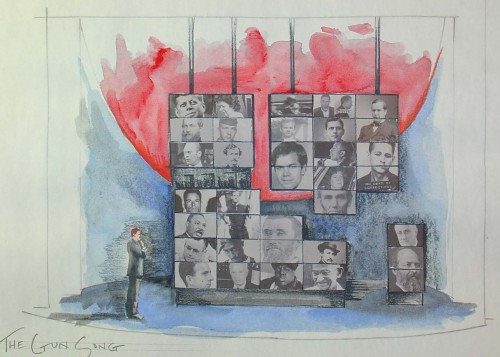
The history of the Presidency serves as a backdrop for the ASSASSINS number.
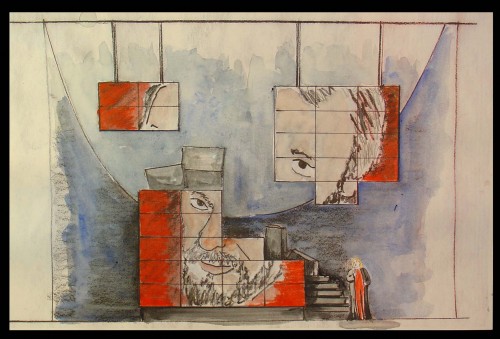
Ultimately, the portrait of Sondheim comes together.
All sketches © 2010 Beowulf Boritt
These drawings and watercolors give an indication of what the set looks like, but they can’t relay the brilliance of the device. It’s magnificently used, and the photos, video and animation on the screens is quite often brilliant. I can’t begin to capture the essence of it, but I can tell you it’s a highlight in theater for me this year.
The orchestrations for this show are by Michael Starobin, and they are just as wonderful as anything else he’s done. The miniscule orchestra never sounds it, and this should show others on Broadway how to do it. It was my pleasure to work with Michael on a number of films he scored for me. I always felt privileged to have him there and excited as any note of music came in for those many films (which included Lyle Lyle Crocodile, Ira Sleeps Over, and Poky Little Puppy’s First Christmas.)
This show is excellent, and it is even more superb if, like me, you’re a Sondheim devotee. You couldn’t ask for more from theater – except perhaps a return to some of those original productions as they sit and grow in my memory. Elaine Stritch singing Ladies Who Lunch, Glynis Johns singing Send in the Clowns, Mako and others singing Someone in a Tree, Mandy Patinkin singing Finishing the Hat – There are just too many others to keep mentioning.
However, I do have to say that in several cases, arrangements and production of some of the songs performed in this show are better than the original versions. The cast of eight sounds brilliant and easily outperforms the British cast that did Sunday in the Park recently at this same theater. Vanessa Williams is truly a star, you can’t take your eyes off of her, yet she sings with the ensemble.
If you have any affinity for Sondheim, go to see this show for a brilliant performance of many of his songs as well as a near-perfect cast and a magnificent set.
Animation &Commentary 07 Apr 2010 10:03 am
Ace in the Hole
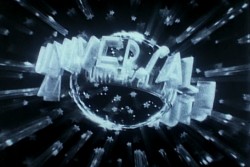 - Back in the day, when I was just a teenager, there was very little in the way of media, as there is today. If you were desperate to become an animator, there weren’t many directions to turn. You had what was on the four or five tv channels that existed and there was the library.
- Back in the day, when I was just a teenager, there was very little in the way of media, as there is today. If you were desperate to become an animator, there weren’t many directions to turn. You had what was on the four or five tv channels that existed and there was the library.
TV offered the Walt Disney show, which two out of four Wednesdays (later Sundays) each month, they’d touch on “Fantasyland”, and 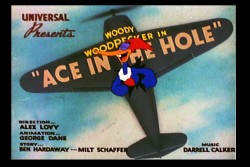 you could watch some Disney cartoons – usually Donald and Chip & Dale, or there was the Woody Woodpecker show, during which Walter Lantz would talk for four or five minutes about some aspect of animation.
you could watch some Disney cartoons – usually Donald and Chip & Dale, or there was the Woody Woodpecker show, during which Walter Lantz would talk for four or five minutes about some aspect of animation.
For all those other hours of the day when you wanted animation you had to make do with what you could create for yourself.
At the age of 11, I took a part time job for a pharmacist delivering drugs to his clientele.
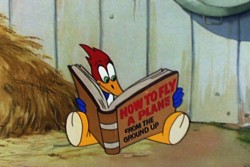 I lived off the tips that were offered, and I saved my money until I had enough to buy a used movie camera. The trek into downtown Manhattan was a big one for an eleven year old child, but I loved it. I went by myself to Peerless camera store near Grand Central Station. (It later merged with Willoughby to become Peerless-Willoughby; then it went back to just being Willoughby.)
I lived off the tips that were offered, and I saved my money until I had enough to buy a used movie camera. The trek into downtown Manhattan was a big one for an eleven year old child, but I loved it. I went by myself to Peerless camera store near Grand Central Station. (It later merged with Willoughby to become Peerless-Willoughby; then it went back to just being Willoughby.)
That store, I quickly learned had a large
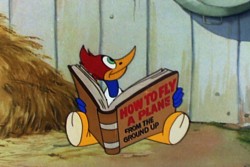 section devoted to films for the 8mm crowd. Lots of Laurel and Hardy, Our Gang and Woody Woodpecker cartoons. Once I had the camera, I saved for a cheap projector and eventually bought some 8mm cartoons.
section devoted to films for the 8mm crowd. Lots of Laurel and Hardy, Our Gang and Woody Woodpecker cartoons. Once I had the camera, I saved for a cheap projector and eventually bought some 8mm cartoons.
Independence. Now, I didn’t have to wait to see them on TV, I could project them myself whenever I wanted. Even better, I jiggered the projector to maneuver the framing device which allowed me to see one frame of the film
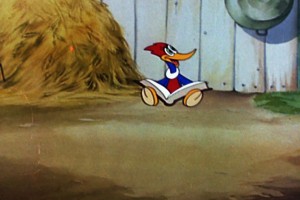 at a time, so that I could advance the frames one at a time. I could study animation.
at a time, so that I could advance the frames one at a time. I could study animation.
I know, I know. I’m describing the stone ages. Today all you have to do is get the DVD (which is incredibly cheap compared to the cost of those old 8mm films) and watch it one frame at a time or any other way you want. And every film is available. If you don’t have it just join Netflix and rent it. Your library is always open and growing.
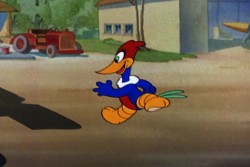
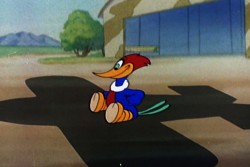
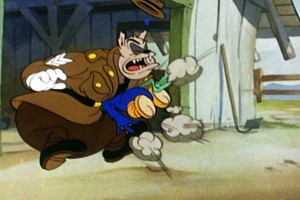 Yes, Peerless had an large 8mm film division, so you could buy the latest Castle film edition of some Woody Woodpecker cartoon, or you could find many of Ub Iwerks’ films. I had a collection of these. Ub Iwerks was my guy. Everything I’d read about him (in the few books available) got me excited about animation. Actually, Jack and the Beanstalk and Sinbad the Sailor were the first films I’d bought and watch endlessly over and over frame by frame.
Yes, Peerless had an large 8mm film division, so you could buy the latest Castle film edition of some Woody Woodpecker cartoon, or you could find many of Ub Iwerks’ films. I had a collection of these. Ub Iwerks was my guy. Everything I’d read about him (in the few books available) got me excited about animation. Actually, Jack and the Beanstalk and Sinbad the Sailor were the first films I’d bought and watch endlessly over and over frame by frame.
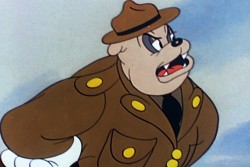 In short time, I knew every frame of Jack and the Beanstalk backwards and forwards. I didn’t realize that it was Grim Natwick who had animated (and directed the animation) on a good part of the film. Meeting Natwick years later, I think I surprised him by saying as much. He just moved on to another subject, appropriately enough.
In short time, I knew every frame of Jack and the Beanstalk backwards and forwards. I didn’t realize that it was Grim Natwick who had animated (and directed the animation) on a good part of the film. Meeting Natwick years later, I think I surprised him by saying as much. He just moved on to another subject, appropriately enough.
In some very real way, I learned animation from that film and several others that I
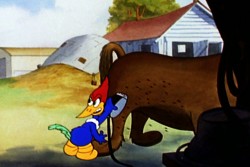 bought in those primative years of my career. Before I knew principles of drawing, I’d been able to figure out principles of animation. I’d had the Preston Blair book, and I had the Tips on Animation from the Disneyland Corner. I just measured what they said about basic rules and watched – frame by frame – how these rules were executed by the Iwerks’ animators. The rest was up to me to figure out, and I was able to do that.
bought in those primative years of my career. Before I knew principles of drawing, I’d been able to figure out principles of animation. I’d had the Preston Blair book, and I had the Tips on Animation from the Disneyland Corner. I just measured what they said about basic rules and watched – frame by frame – how these rules were executed by the Iwerks’ animators. The rest was up to me to figure out, and I was able to do that.
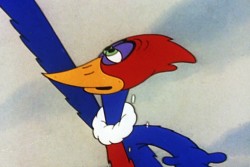
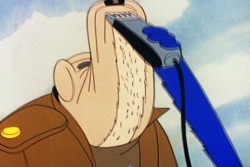
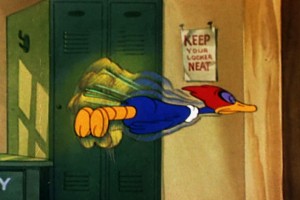 Eventually I bought a Woody Woodpecker cartoon. I was reluctant because so many of them were the very limited films done in the early 60′s – Ma and Pa Beary etc. It took a while to figure out that Ace in the Hole was a wartime movie and the animation would be a bit better. It was also the Woody that I liked – just a bit crazy. So I sprang for it and swallowed that film’s every frame for years.
Eventually I bought a Woody Woodpecker cartoon. I was reluctant because so many of them were the very limited films done in the early 60′s – Ma and Pa Beary etc. It took a while to figure out that Ace in the Hole was a wartime movie and the animation would be a bit better. It was also the Woody that I liked – just a bit crazy. So I sprang for it and swallowed that film’s every frame for years.
 I’m not sure who George Dane is, (he seems to have spent years at Lantz before working years at H&B and Filmation) but I studied and analyzed his animation on this film closely and carefully.
I’m not sure who George Dane is, (he seems to have spent years at Lantz before working years at H&B and Filmation) but I studied and analyzed his animation on this film closely and carefully.
The work reminded me of some of the animation done for Columbia in the early 40′s. It had that same mushiness while at the same time not breaking any of the rules. Regardless, he knew what he was doing, and I had a lot to learn from him. And I did.
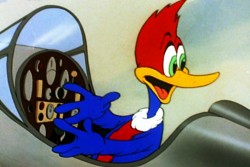
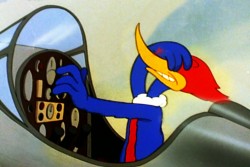
 Things keep changing, media keeps growing. I’m glad I had to fight to get to see any of those old 8mm shorts back in the early years. When I bought my first vhs copy of a Disney feature, it took a while to grasp the fact that I could see every frame of it whenever I wanted. In bygone years, I could only see the rejects that TV didn’t want. I wanted to study Tytla and Thomas and Natwick and Kahl. Instead, I studied George Dane. And you know what, it was pretty damn OK. I
Things keep changing, media keeps growing. I’m glad I had to fight to get to see any of those old 8mm shorts back in the early years. When I bought my first vhs copy of a Disney feature, it took a while to grasp the fact that I could see every frame of it whenever I wanted. In bygone years, I could only see the rejects that TV didn’t want. I wanted to study Tytla and Thomas and Natwick and Kahl. Instead, I studied George Dane. And you know what, it was pretty damn OK. I 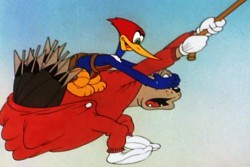 learned enough that I knew a lot when I started in the business. I just jumped in and was animating for John Hubley within days of getting that first job. (It helps that it was an open studio like Hubley’s where the individual artist could do anything, as long as he kept his head above water. In most studios there’s a rigidity that keeps you in your classified job.) In fact by then, I was more interested in Art Direction and Direction than I was in animation, but that’s another post.
learned enough that I knew a lot when I started in the business. I just jumped in and was animating for John Hubley within days of getting that first job. (It helps that it was an open studio like Hubley’s where the individual artist could do anything, as long as he kept his head above water. In most studios there’s a rigidity that keeps you in your classified job.) In fact by then, I was more interested in Art Direction and Direction than I was in animation, but that’s another post.
If you want to learn from the masters, just pop in a DVD and watch it frame-by-frame. If you don’t get a charge out of it, you might begin to wonder if you’re really in the right business. After all these years, I still get the thrill, and I imagine I always will – even from watching Ace in the Hole AGAIN.
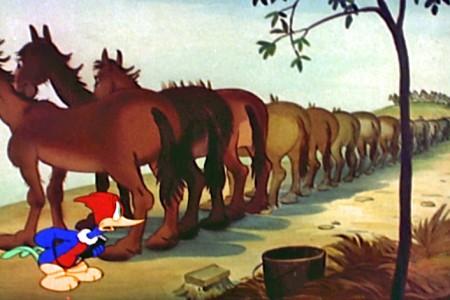
Commentary &Daily post 24 Mar 2010 08:14 am
Popeye, Burton & Sandy
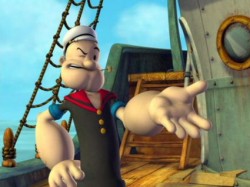 - Good news for Segar lovers! Variety reports that Popeye is going cgi and Sony is about to make the film. Naturally, it’ll be in 3D so that when Bluto gets smashed out of the audience he can fly over our heads. The film will be directed by a relative neophyte, Mike Jones. He’d written a film called Eventland and another The Minotaur Takes a Cigarette Break which is now in production.
- Good news for Segar lovers! Variety reports that Popeye is going cgi and Sony is about to make the film. Naturally, it’ll be in 3D so that when Bluto gets smashed out of the audience he can fly over our heads. The film will be directed by a relative neophyte, Mike Jones. He’d written a film called Eventland and another The Minotaur Takes a Cigarette Break which is now in production.
He doesn’t quite have the experience of theatrical director Des McAnuf who did The Adventures of Rocky and Bullwinkle or Peter Hewitt (Bill and Ted’s Bogus Journey) who did Garfield, but he brings plenty of enthusiasm. It should be fun, but I’m not sure if it’ll be better than Bob Altman’s Popeye. Then again, it will be 3D.
The good news is that the great compilation DVDs of the Fleischer years is still available from Amazon. Even after you’ve seen the cgi 3D Popeye you can come home to clear your palate with these first class copies of the original shorts.
- Then again, the other animated feature announced this past week sounds heavenly. According to the March 18th Nikki Finke article, Tim Burton‘s going to do a 3D puppet animated version of The Addams Family with Chris Meladandri producing. Sounds like an ideal marriage. However, the next day, according to Screen Rant, the Burton people adamantly denied the project had anything to do with the director. Let’s hope that Nikki Finke is correct – as she often is.
Johnny Depp and Helena Bonham Carter would make an original Morticia and Gomez.
- Years ago children’s television wasn’t quite the slick wonderland that it is now. It was less of a babysitter, but on a local level tv stations tried a lot harder often depending on flamboyant actors to develop characters. These were usually voice over announcers who put on costumes and let ‘er rip.
In New York, you had the Sunday shows that included Wonderama on ch. 5 – before it had anything to do with Fox – and you had the Chuck McCann show on ch. 11 – before it had anything to do with the WB (or whatever they call themselves today.) McCann was a crazy kinda guy who read the comic strips in funny voices and wigs and entertained us all silly.
During the week, there were Johnny Jellybean, starring Joe Bova. He shared his lunch with us during the day and starred in Once Upon a Mattress on Broadway at night. The morning shows were mostly B&W cartoons with hosts like Cap’n Allan Swift – replaced by Cap’n Jack McCarthy – introducing Popeye and Officer Joe Bolton who gave us the Three Stooges.
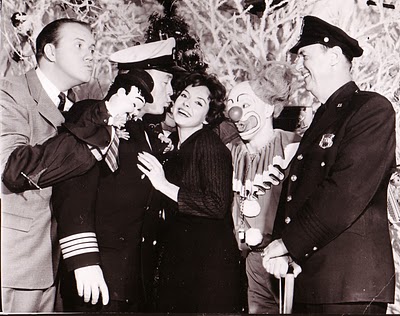
The ch. 11 roundup: Chuck McCann (with Laurel & Hardy puppets),
Captain Jack McCarthy, Gloria Okon, Bill BOZO Britten, and
Officer Joe Bolton.
The mornings belonged to Sandy Becker. He was a manic kinda guy who seemed to be 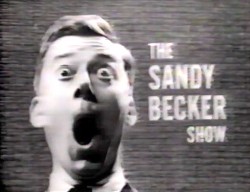 talking to kids but really playing for the grown ups using kids toys and games. I remember well how he did his best to destroy a Mr. Machine robot as he demonstrated the host, Mattel’s product. The robot kept walking off the desk. I remember another show where Sandy didn’t show up at the beginning of the program and they kept running B&W WB cartoons. Mid show he appeared somewhat breathless, and advised us kiddies that if we happened to see a red Volkswagen with such and such a license plate, could we call the
talking to kids but really playing for the grown ups using kids toys and games. I remember well how he did his best to destroy a Mr. Machine robot as he demonstrated the host, Mattel’s product. The robot kept walking off the desk. I remember another show where Sandy didn’t show up at the beginning of the program and they kept running B&W WB cartoons. Mid show he appeared somewhat breathless, and advised us kiddies that if we happened to see a red Volkswagen with such and such a license plate, could we call the 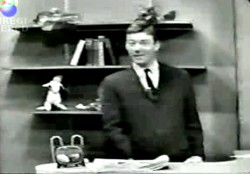 police because his car had disappeared that morning.
police because his car had disappeared that morning.
You can see some of the nastier bits here.
I guess he had a one hour special in those years: Sandy Becker’s Christmas Carol. It featured a lot of the puppets and characters that appeared on his show. I’d received an email from Craig Marin of Flexitoons who is trying to “reimagine” the show for DVD. Here’s how they state it in their press release:
- The program starred Sandy’s entire ensemble of puppets – most memorably Geeba Geeba as Scrooge, Sir Clive as Bob Cratchit, and Marvin Mouse as Tiny Tim.
For Millions of Baby Boomers, who grew up with Sandy as a vital member of their “TV-family”, it was their first introduction to Charles Dickens ghostly tale of greed and redemption. To this day, Sandy’s production lives warmly in their hearts and fondly in their memories. Unfortunately, as was the case with many live programs of the time, the tapes – to the best of anyone’s knowledge – were destroyed or erased or taped-over. 
 

In the 1990‘s Sandy and Flexitoon partner Craig Marin – who as a child was greatly influenced by Sandy and later became his friend as an adult – often talked about and planned to remake his Christmas Carol. But sadly, when Sandy passed away those plans were put on hold.
Now, through the power of Kickstarter, the Holiday special is back on track. FLEXITOON, one of America’s premier puppet production companies on television, film and stage is ready to produce a re-imagining of Sandy Becker’s Christmas Carol, using all the original puppets he bequeathed to them upon his passing.
You can see a video presentation here.
You can go to their Facebook page here.
- I’ve waited patiently for Mike Barrier to give his thoughts on the passing of Fess Parker. He didn’t disappoint with the excellent piece and companion interview that appears today on his blog. Mike showed us the man, Fess Parker, as opposed to the memorabilia which appeared in many other obituaries. (Come to think of it, Mike did the same for Walt Disney with his book, The Animated Man.) If you have any interest in the star of a Disney series that rocked the world for 15 minutes in the 1950′s, then head on over to his site.
Commentary 21 Mar 2010 08:10 am
Outta Biz Photo
- In case you were wondering what happens to old animation studios, I thought I’d post this flyer I received in the mail yesterday. It arrived just in time for the release this week of the Astroboy DVD.
 1
1(Click any image to enlarge.)
Not a pretty site. All those cubicles (on pg. 3) were once filled with people manipulating images of Astroboy and Ninja Turtles. Now they’re just piles of objects to be sold. Perhaps another adventurous producer will buy it all to start a new production.
But then, I was searching to see if there was a tilted desktop pictured in the whole. Of course not. Lots of G5s though. Wonder if they have any software on them.
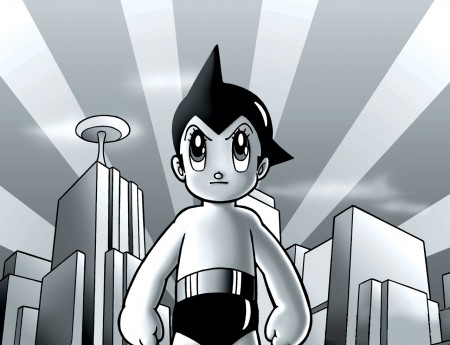
Oh wait. Not that one.
At least, it’ll live on in DVD.
Commentary &Disney 18 Mar 2010 08:39 am
Waking Sleeping Beauty
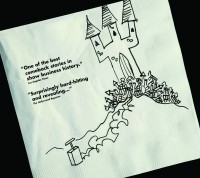 - Waking Sleeping Beauty is a tightly edited documentary detailing the years between 1984 and 1994 at the Disney Animation Studio. From The Black Cauldron through The Lion King. There’s ample footage of the artists in meetings – particularly story meetings, goofing around and walking the halls of the old Animation building on the Disney lot.
- Waking Sleeping Beauty is a tightly edited documentary detailing the years between 1984 and 1994 at the Disney Animation Studio. From The Black Cauldron through The Lion King. There’s ample footage of the artists in meetings – particularly story meetings, goofing around and walking the halls of the old Animation building on the Disney lot.
Yet the story being told – without an iota of fat – is the story of the above-the-line players and how they felt about each other. The machinations and power plays they work on each other to wrest control and credit for the studio’s success is the primary interest of this film, not the attitudes and thoughts of the animation people.
Only a couple of times do we really get to imagine how the artists felt about what was going on. There’s a meeting called by Katzenberg to talk about how the people felt about the period. They explained that they weren’t able to spend appropriate time with their families because of all the excess overtime that was demanded of them. Katzenberg tears up and promises that things will get better. They don’t; things get worse.
Throughout the film is colored with home movie footage taken by Randy Cartwright of a lot of the animators and artists mugging for the camera. The only shot that gives an inkling that something serious is going on is a shot where Tim Burton is caught at his drawing board, and he literally doesn’t know what to do. Frustration, irritation and annoyance beams off his face. It was one of the biggest laughs for the audience surrounding me. There are ample and tight closeups of many of these people: Tom Sito, Andreas Deja, Eric Goldberg, Joe Ranft, Roger Allers, Mike Gabriel and many more. Yet, none of them – NONE – are labelled and identified.
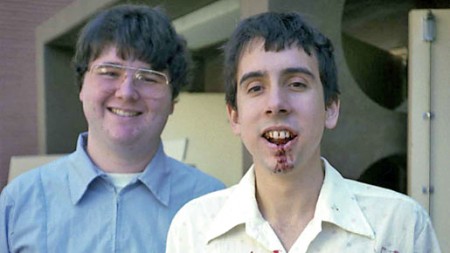
Joe Ranft and Tim Burton still don’t recieve identification in this film.
Yet their images are known by many outside the industry.
Yet, every executive gets clear identification. Even the full list of end credits runs alongside running footage of people/artists in the studio saying hello and playing for the camera. Yet, none of these people are identified. I’m not even sure their names appeared in the credits since it was hard to watch the running type while trying to see the archival footage.
Despite this complaint, the story told was engrossing. Since I can identify most of the people, I was also absorbing every frame of the home movies and the footage shot for PR sake that also filled the film.

Howard Ashman and Alan Menken are given the due credit for both The Little Mermaid and Beauty and the Beast and, to some extent, Aladdin. Ashman, as we know, had a lot to do with the shaping of both films. I’d already given credit to him for much of the guidance of the two films, so it was good to see the filmmakers support this. In many ways, in my mind, a great deal of credit for this renaissance fell on his shoulders.
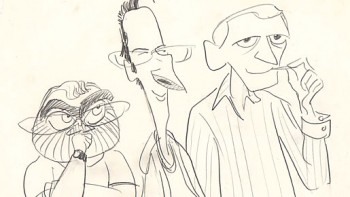 In fact, I’m surprised, given the enormous success the studio has had over the years with Alan Menken’s songs and music, that they didn’t bring him in for The Princess and the Frog. Menken brought good luck to so many of the animated features of this period that one wonders if it may have helped. Given his successful track record, there was more likelihood that he might have brought something to the film. They were trying to reboot their musical franchises, yet they turned to Randy Newman – who’d been hit and miss for them at Pixar. Perhaps the Pixar connection gave Newman the upper hand with John Lasseter, probably finalizing that decision.
In fact, I’m surprised, given the enormous success the studio has had over the years with Alan Menken’s songs and music, that they didn’t bring him in for The Princess and the Frog. Menken brought good luck to so many of the animated features of this period that one wonders if it may have helped. Given his successful track record, there was more likelihood that he might have brought something to the film. They were trying to reboot their musical franchises, yet they turned to Randy Newman – who’d been hit and miss for them at Pixar. Perhaps the Pixar connection gave Newman the upper hand with John Lasseter, probably finalizing that decision.
The film includes newly recorded interviews with many of the higher salaried artists which overlapped some of the footage and helped to move the story. Eisner, Katzenberg or Roy Disney are also seen in detailed comments taken from press releases, all of which underlines the lust for power over the animation studio. The fever pitched competition between Disney and Katzenberg is certainly highlighted.
Don Hahn directs the film with assuredness, and he acts as the primary narrator – though, producer, Peter Schneider‘s high-pitched comments certainly color the film as well.
It’s a tense and serious attempt to record a POV of one very successful period at the Disney studio, and to a great extent they get it. However, since it is made by two people in a position of power, their interest is definitely focussed on the four people above them – Eisner, Disney, Katzenberg and Wells. To be honest, I’m not sure the drama would have held if you’d concentrated on the people below their level. However, I do think the artists deserve at least to have been identified.
It’s a very entertaining film for those interested in animation and Disney, in particular.
The film opens in four cities on March 26th: NY, LA, SF and Chi. You can see it at the Landmark Sunshine theater in NY.
Commentary 16 Mar 2010 07:52 am
Haiti and other stuff
- I received the following film in an email from Karl Cohen in San Francisco. Karl writes: “Alan Sperling is a former employee of Richard Williams when he had a studio in LA and has worked in SF for many years.”
In fact Alan also animated on Cool World, Toy Story, and Monsters Inc.
He did the following film, Scratch, for the Haitian relief effort and he’s just trying to get it seen by as many people as possible. So take a look, if you haven’t seen it as yet.
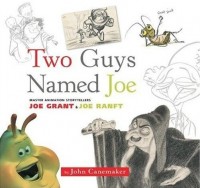 - Recent posts about the internet toast the 50th birthday of the late Joe Ranft.
- Recent posts about the internet toast the 50th birthday of the late Joe Ranft.
I think the most fitting tribute for this man will come later this year when John Canemaker‘s beautifully written and sensitive book, Two Guys Named Joe arrives in book stores. The stories of Joe Ranft and Joe Grant are detailed, elaborated and interrelated without an iota of sentimentality. This is a gorgeous and strong book and a magnificent tribute to both Ranft and Grant. It’s one of the best books in John’s canon. Look for it in August.
 Speaking of Joe Ranft, I saw a screening at MOMA last night of Waking Sleeping Beauty, a must for any animation enthusiast. It’s a fast paced intriguing story when all layed out. I’ll review the film later this week. I just wanted to mention that Joe Ranft was featured prominently (though never identified) throughout the film. He, obviously, was a big part of that period.
Speaking of Joe Ranft, I saw a screening at MOMA last night of Waking Sleeping Beauty, a must for any animation enthusiast. It’s a fast paced intriguing story when all layed out. I’ll review the film later this week. I just wanted to mention that Joe Ranft was featured prominently (though never identified) throughout the film. He, obviously, was a big part of that period.
I also got to meet Tomm Moore, who sat in front of me, at the screening. I’m pleased to finally be able to put a face to The Secret of the Kells. I’ve seen the film twice and have a lot of respect for the enormous production he was able to pull off so successfully. It’s so hopeful for all of us independents to see the little guy with so tiny a distributor making such large waves.
- Other sites talk about the press release this past week of Disney’s closing Imagemovers Digital, the company Robert Zemeckis used to make his last couple of MoCap features. This was hardly great news given the costs that those films absorbed. When the Jim Carrey Christmas Carol costs $174 million, it’s unlikely to return its investment. Ultimately, it will probably break even, but one wonders if the same financial “success” wouldn’t have been achieved using traditional animation. When Bolt costs $150 million and returns $114 from US receipts, it’s averaging about the same as the $50 million loss Christmas Carol currently shows. Beowulf had a $150 million budget and brought in $82 million.
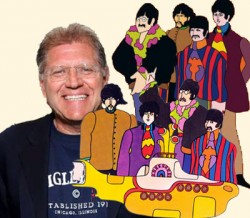 It seems clear to me that the writing was on the wall. The wonder is that Disney still has the deal to release The Yellow Submarine. Undoubtedly that film will ignore the great graphics of the original to bring us a MoCap version of the four Beatles – in that wonderful Zemeckis “walking-dead” style. How much can that lose – and cost?
It seems clear to me that the writing was on the wall. The wonder is that Disney still has the deal to release The Yellow Submarine. Undoubtedly that film will ignore the great graphics of the original to bring us a MoCap version of the four Beatles – in that wonderful Zemeckis “walking-dead” style. How much can that lose – and cost?
Remember, a bad movie is a bad movie, whether it’s traditionally animated like Treasure Planet or cgi like Space Chimps or MoCap like Beowulf. Disney’s not moving away from financing bad movies, they’re cutting costs on financial risks.
- For those of you not living in New York, this is the kind of outdoor advertising Adult Swim uses to promote its wares.

.

.
Almost as good as the shows themselves. 25% P’Toots.
________________
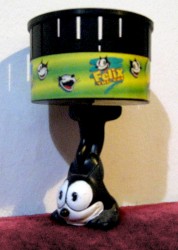 - Finally, I wanted to revisit something Amid Amidi posted on Cartoon Brew over the weekend. Brian Duffy wrote to me to introduce me to a couple of sites. As an enormous fan of optical toys, with a mini collection of non-authentic pieces of my own, I rushed to look at the wares on the site, the Richard Balzer collection. There, I loiotered for hours and have returned many times since first viewing them. Everyting from Praxinoscopes to Thaumatropes to Zoetropes are displayed in a stunning collection of artifacts in this wealthy collection. They also have a blog, dickbalzer.blogspot.com, which is demonstrating via flash videos how the pieces operate. I look forward to viewing some of the zoetrope animations and will continue to return for updated pieces. I love this stuff.
- Finally, I wanted to revisit something Amid Amidi posted on Cartoon Brew over the weekend. Brian Duffy wrote to me to introduce me to a couple of sites. As an enormous fan of optical toys, with a mini collection of non-authentic pieces of my own, I rushed to look at the wares on the site, the Richard Balzer collection. There, I loiotered for hours and have returned many times since first viewing them. Everyting from Praxinoscopes to Thaumatropes to Zoetropes are displayed in a stunning collection of artifacts in this wealthy collection. They also have a blog, dickbalzer.blogspot.com, which is demonstrating via flash videos how the pieces operate. I look forward to viewing some of the zoetrope animations and will continue to return for updated pieces. I love this stuff.
By the way, the toy zoetrope to the right is one I own, a giveaway from Wendy’s back in the ’90s.
Books &Commentary &Richard Williams 11 Mar 2010 08:58 am
Dick Williams’ Survival Kit
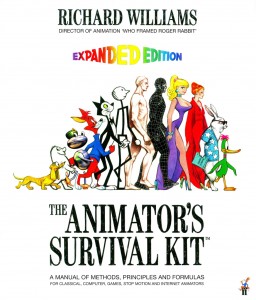 - Richard Williams, as we all know, was the genius who single-handedly fostered the renaissance of animation in the 60s & 70s. His London studio became the center of animation when the Disney studio faltered for that period.
- Richard Williams, as we all know, was the genius who single-handedly fostered the renaissance of animation in the 60s & 70s. His London studio became the center of animation when the Disney studio faltered for that period.
Or maybe we only know him as the author of that book, The Animator’s Survival Kit. That’s the book in which he has put his immense knowledge about the technique of animation, and there’s also his series of DVD lectures. Or maybe it’s the series of lectures and the companion book.
Recently released is the revised edition of the book which is at least 40 pages longer and includes a sample DVD to give an idea of his lecture series.
Both books are identical until page 339, the new book expands on the original. It talks about what Williams calls, “. . . the more difficult areas of animation,” such as animal action and gaits and offers suggestions on how to correctly use live action, to help push the medium further. (No mention is made of Motion Capture.) In fact, there’s a long piece comparing use of semi-realistic to cartoon animation.
The book says it’s for all types of animation from 2D to cg from puppet to highly rendered. However, to me, it feels more inclined to speak to the 2D drawing animator. I’m sure there are a lot of lessons the cg animator can and should take from the book, but I’m not sure how much use will be made of it.
Some of the lessons are excellent, but I wonder if others aren’t too sophisticated for those who will use the book to actually learn the craft. In fact, at first glance it looks like the Preston Blair book on acid, but Dick goes into a discussion about the Blair book and then builds on it, taking the material into a very complicated world. The delight is that Dick never sees his lessons as compicated, but moves straight on assuming we’ll all follow. The pages are hand lettered for the final 2/3 of the book, and this is particularly inviting for the artists out there. Howver, the drawings are dense with information and material and should not be confused with anything less than what they are. Richly informative.
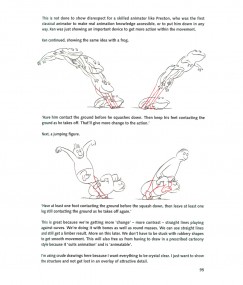 a
a 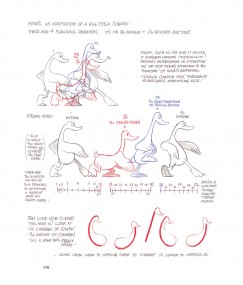 b
b
At first glance, the book looks like an update of the Preston Blair book, but
Dick takes on that point and builds from there leaving no doubt for the reader.
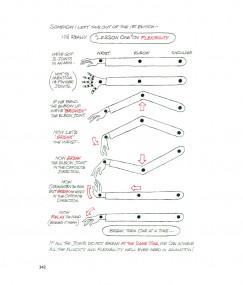 c
c 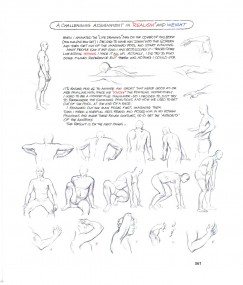 d
d
The additions are literally added to the end. 40 odd pages that are devoted
to more compicated motion patterns or things Dick left out the his original book.
It’s quite a tool if you use it well. A course, in itself, within the 380 pages. Every dedicated animator should own one, and then they own it they should read it.
Commentary 05 Mar 2010 08:59 am
Coming and going
 - It all started on Wednesday when Michael Riedel, the NYPost’s gossip theater columnist, said that Disney theatricals were aiming to bring Dumbo to Broadway as their next big thing. Riedel said that Disney wanted Stephen Daldry (Billy Elliot, the movie and the musical) to helm the transfer, but they were having a hard time convincing him to do the job.
- It all started on Wednesday when Michael Riedel, the NYPost’s gossip theater columnist, said that Disney theatricals were aiming to bring Dumbo to Broadway as their next big thing. Riedel said that Disney wanted Stephen Daldry (Billy Elliot, the movie and the musical) to helm the transfer, but they were having a hard time convincing him to do the job.
Today in the NYTimes Artsbeat column, the story develops a bit more fully. Disney says that they’re in the very start of development and there’s no immediate plans to take Dumbo to Broadway. In fact, they don’t know where it’ll end up. They did say that Stephen Daldry approached them with the idea, and he is very much the man behind the musical.
Riedel gets about 1/3 of the information and the Times gets another third. Though Disney pooh-pooh’s the idea of thinking of Broadway for it, they wouldn’t have hired so expensive a person as Stephen Daldry if in fact Broadway weren’t the end game. I’m just curious as to how they’re going to develop a one hour aimated feature into a two and a half hour extravaganza. I can’t wait to see “Pink Elephants on Parade,” and those crows should steal the show.
 Today, Michael Riedel states that Bobby Steggert will play Dumbo. Steggert appeared in the Broadway revival of Ragtime (that recently closed) and 110 In the Shade. The casting would make it seem closer to reality than Diseny would admit.
Today, Michael Riedel states that Bobby Steggert will play Dumbo. Steggert appeared in the Broadway revival of Ragtime (that recently closed) and 110 In the Shade. The casting would make it seem closer to reality than Diseny would admit.
I was nervous that it’d be Brian D’Arcy James. After spending a million hours in the makeup chair playing Shrek, I couldn’t imagine him sitting still to take the turn into playing an elephant.
Riedel also writes that, “. . . Stevie Wonder has been approached to write additional songs, although he has reservations because of the ‘racist’ aspects of the old movie.” I suppose they also chose him just to offset those very same “racist” aspects.
The NYTimes has also been writing quite some about The Secret of the Kells and the tough road this independently produced and distributed feature has in trying to win the Oscar vs some of the big studios. Even the smallest of the rest has some major forces behind it. However, I wonder why the article would arrive at our newstand doors so late in the season. Oscar ballots were due back this past Tuesday; it’s a little too late to vote for the film.
However, it’s not too late to see it. The film is currently playing in New York at the IFC center with many shows daily. See it if you haven’t. The film is also reviewed in today’s NYTimes by A.O.Scott. A generally positive review there are a lot of quotes one could choose. “Using the vivid colors and delicate lineations of the Book of Kells for inspiration, he establishes a surprising and completely persuasive link between the ancient art of manuscript illumination and the modern practice of animation. Like the crystal lens that is a crucial element of Aidan’s craft — an enchanted eye that refracts and renews his, and then Brendan’s, perception — ‘The Secret of Kells’ discloses strange new vistas that nonetheless seem to have existed since ancient times.”
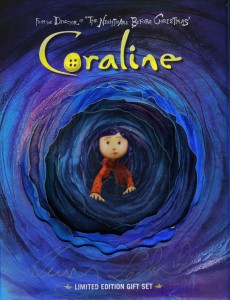 Fitting somewhat in the same category is the exclusive box of 3D DVD Coraline sent me this past week. A beautiful box full of a booklet promoting their film, a DVD (one side 2D the other 3D), another DVD of extras and four pair of glasses. The box was individually signed by Henry Selick.
Fitting somewhat in the same category is the exclusive box of 3D DVD Coraline sent me this past week. A beautiful box full of a booklet promoting their film, a DVD (one side 2D the other 3D), another DVD of extras and four pair of glasses. The box was individually signed by Henry Selick.
It’s a bit too late for Oscar voting, so I have to assue this was FedExed to me to review as a product on the market. (I’ve been getting a lot of this stuff lately.) I’d be quite happy if this beats UP at the Oscar on Sunday, though I’ve already said that I’m enthusiastically for Fantastic Mr. Fox.)
Regardless, it’s a beautiful package and I love having it. I will write more about it after I see the film again in 3D this weekend. The Coraline people (director, producers and distributor) treated this film and their audience as a class act all the way, and it’s worth my time to write about it again.
- I just did three seconds worth of research to learn that this DVD package was released to the public as a “Special Edition.” I’m glad to see that.
Congratulations to John Canemaker for getting the Print Magazine people to allow him a blog, which he’ll post, once a month. John writes, “The blog format will allow me to explore everything that reflects my eclectic interests, from Giotto to Johnny Gruelle, Elaine Stritch to Snow White, with the same personal perspective I bring to my teaching, lectures, and books.â€
Sounds like some exciting posts are to come. John needs something larger on the internet, and this seems small in comparison to what I might hope for. We’ll see as it develops. In the meantime, take a look at John’s main site. There are lots of writing and artwork within.
